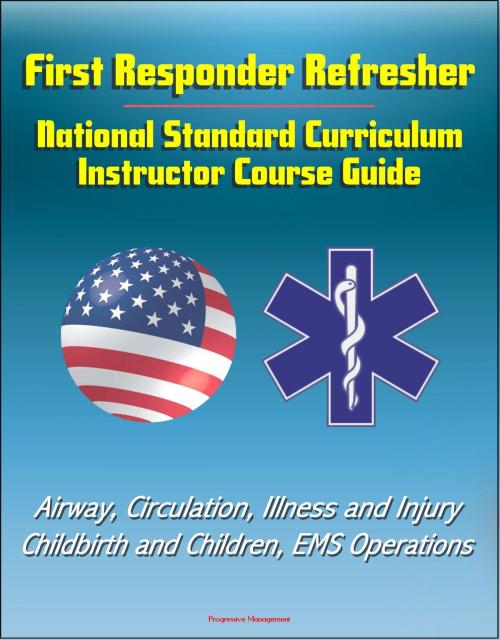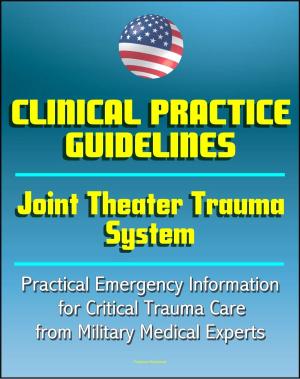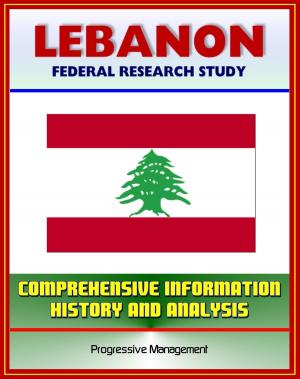First Responder Refresher: National Standard Curriculum Instructor Course Guide - Airway, Circulation, Illness and Injury, Childbirth and Children, EMS Operations
Nonfiction, Health & Well Being, Medical, Allied Health Services, Emergency Medical Services, Specialties, Emergency Medicine| Author: | Progressive Management | ISBN: | 9781476147246 |
| Publisher: | Progressive Management | Publication: | August 30, 2012 |
| Imprint: | Smashwords Edition | Language: | English |
| Author: | Progressive Management |
| ISBN: | 9781476147246 |
| Publisher: | Progressive Management |
| Publication: | August 30, 2012 |
| Imprint: | Smashwords Edition |
| Language: | English |
The First Responder is an integral part of the Emergency Medical Services System. The term "first responder" has been applied to the first individual who arrives at the scene regardless of the individual's type of credential. It is the goal of the First Responder: National Standard Curriculum to provide students with the core knowledge, skills and attitudes to function in the capacity of a first responder. The First Responder uses a limited amount of equipment to perform initial assessment and intervention and is trained to assist other EMS providers. This level of provider is not intended to be utilized as the minimum staffing for an ambulance. Enrichment programs and continuing education will help fulfill other specific needs for the First Responder training.
It is recognized that there may be additional specific education that will be required of First Responders who operate in the field. It is also recognized that practice might differ from locality to locality, and that each training program, or system should identify and provide additional training requirements. Consistent with the intent and design of the National EMS Education and Practice Blueprint, some EMS systems will incorporate additional skills into the scope of practice of the First Responder.
Preface * Process * Cardiopulmonary Resuscitation * Integration with the Blueprint * Medical Oversight Statement * Curriculum * Course Goals * Diagram of Educational Model * Course Design * How to Use the Curriculum and Lesson Plans * Instructors * Assessing Student Achievement * Philosophy Regarding Adult Learners * Some Principles of Adult Education * Conducting Patient Care Simulations in the Classroom * Continuing Education * Students * Job Description - First Responder * Continuing Education and Its Importance in Lifelong Learning * Environment * Classroom Environment * Maintaining Records * Credentialing * Program Evaluation * Facilities * Course Cost * Module 1: Preparatory * Lesson 1-1 Introduction to EMS Systems * Lesson 1-2 The Well-Being of the First Responder * Lesson 1-3 Legal and Ethical Issues * Lesson 1-4 The Human Body * Lesson 1-5 Lifting and Moving Patients * Module 2: Airway * Lesson 2-1 Airway. * Module 3: Patient Assessment * Lesson 3-1 Patient Assessment * Module 4: Circulation * Lesson 4-1 Circulation * Module 5: Illness and Injury * Lesson 5-1 Medical Emergencies * Lesson 5-2 Bleeding and Soft Tissue Injuries * Lesson 5-3 Injuries to Muscles and Bones * Module 6: Childbirth and Children * Lesson 6-1 Childbirth * Lesson 6-2 Infants and Children * Module 7: EMS Operations * Lesson 7-1 EMS Operation * Appendices. * APPENDIX A: BLS HeartSaver Information and Skill Sheets * APPENDIX B: Adult and Pediatric Basic Cardiac Life Support * Guidelines reprinted from JAMA * APPENDIX C: Enrichment Lesson Plan * APPENDIX D: Remediation Sheet * APPENDIX E: Patient Assessment Flow Charts * APPENDIX F: Final Practical Skills Exam
The First Responder is an integral part of the Emergency Medical Services System. The term "first responder" has been applied to the first individual who arrives at the scene regardless of the individual's type of credential. It is the goal of the First Responder: National Standard Curriculum to provide students with the core knowledge, skills and attitudes to function in the capacity of a first responder. The First Responder uses a limited amount of equipment to perform initial assessment and intervention and is trained to assist other EMS providers. This level of provider is not intended to be utilized as the minimum staffing for an ambulance. Enrichment programs and continuing education will help fulfill other specific needs for the First Responder training.
It is recognized that there may be additional specific education that will be required of First Responders who operate in the field. It is also recognized that practice might differ from locality to locality, and that each training program, or system should identify and provide additional training requirements. Consistent with the intent and design of the National EMS Education and Practice Blueprint, some EMS systems will incorporate additional skills into the scope of practice of the First Responder.
Preface * Process * Cardiopulmonary Resuscitation * Integration with the Blueprint * Medical Oversight Statement * Curriculum * Course Goals * Diagram of Educational Model * Course Design * How to Use the Curriculum and Lesson Plans * Instructors * Assessing Student Achievement * Philosophy Regarding Adult Learners * Some Principles of Adult Education * Conducting Patient Care Simulations in the Classroom * Continuing Education * Students * Job Description - First Responder * Continuing Education and Its Importance in Lifelong Learning * Environment * Classroom Environment * Maintaining Records * Credentialing * Program Evaluation * Facilities * Course Cost * Module 1: Preparatory * Lesson 1-1 Introduction to EMS Systems * Lesson 1-2 The Well-Being of the First Responder * Lesson 1-3 Legal and Ethical Issues * Lesson 1-4 The Human Body * Lesson 1-5 Lifting and Moving Patients * Module 2: Airway * Lesson 2-1 Airway. * Module 3: Patient Assessment * Lesson 3-1 Patient Assessment * Module 4: Circulation * Lesson 4-1 Circulation * Module 5: Illness and Injury * Lesson 5-1 Medical Emergencies * Lesson 5-2 Bleeding and Soft Tissue Injuries * Lesson 5-3 Injuries to Muscles and Bones * Module 6: Childbirth and Children * Lesson 6-1 Childbirth * Lesson 6-2 Infants and Children * Module 7: EMS Operations * Lesson 7-1 EMS Operation * Appendices. * APPENDIX A: BLS HeartSaver Information and Skill Sheets * APPENDIX B: Adult and Pediatric Basic Cardiac Life Support * Guidelines reprinted from JAMA * APPENDIX C: Enrichment Lesson Plan * APPENDIX D: Remediation Sheet * APPENDIX E: Patient Assessment Flow Charts * APPENDIX F: Final Practical Skills Exam















